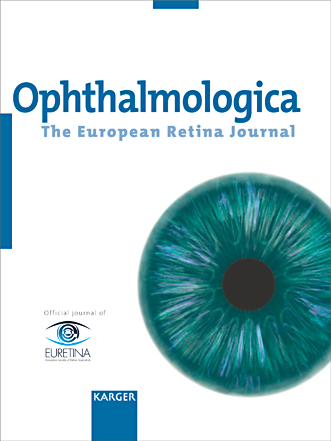Ophthalmologica - Edited by Sebastian Wolf
Vol: 243 Issue: 3

Sebastian Wolf
Published: Monday, June 1, 2020
 Risk factors identified for retinal pathologies in fellow-eye PCV patients
Unilateral polypoidal choroidal vasculopathy (PCV) contralateral eyes with BVN requires careful monitoring for future development of PCV or neovascular AMD (nAMD) choroidal neovascularisation, a retrospective study suggests. The study included 48 patients with unilateral PCV. At five years’ follow-up, 17% developed PCV or CNV in their fellow eye. Baseline characteristics in the fellow eye that correlated significantly with the development of PCV included subfoveal choroidal thickness (p = 0.001), irregular retinal pigment epithelium elevation (p < 0.001), choroidal vascular dilation (p < 0.001), choroidal vascular hyperpermeability (p < 0.001) and the presence of branching vascular network (BVN )(p < 0.001). The only significant risk factor for the development of nAMD was BVN (p = 0.045, odds ratio = 24.66).
K Kim et al, “Five-Year Follow-Up of Unaffected Fellow Eyes in Patients with Polypoidal Choroidal Vasculopathy”, Ophthalmologica 2020, Volume 243, Issue 3.
Autofluorescent lifetimes longer in geographic atrophy than Stargardt’s disease
A new study indicates that atrophic regions of the retinal pigment epithelium (RPE) have longer autofluorescence lifetimes in patients with age-related macular degeneration (AMD) than they do in eyes with Stargardt’s disease (STGD). In 30 geographic atrophy patients with a mean age of 78 years, mean retinal autofluorescence lifetimes were significantly longer than in 13 STGD patients with a mean age of 43.7 years, in both the short 498-560nm spectral channel (997ps vs 363ps) and the long 560-720nm spectral channel (880ps vs 39 ps). The findings may provide additional clues into the pathogenetic mechanisms underlying the conditions, the authors note.
Y Solberg et al, “Fluorescence Lifetime Patterns of Retinal Pigment Epithelium Atrophy in Patients with Stargardt Disease and Age-Related Macular Degeneration”, Ophthalmologica 2020, Volume 243, Issue 3.
TPA and SF6 gas effective in lifting submacular haemorrhages
Intravitreal injection recombinant tissue plasminogen activator (rtPA) and sulphur hexafluoride gas (SF6) can displace large submacular haemorrhages (SMH), allowing postoperative diagnostic testing to guide further treatments, a new study indicates. The authors analysed medical records of 96 consecutive SMH patients who underwent intravitreal injection of rTPA and SF6 followed by face-down positioning. They found that the SMH was displaced from the fovea in 76% of eyes. There were statistically significant correlations between the macular findings revealed after blood displacement and the additional treatments selected for the underlying disease.
E Maggio et al,“Intravitreal Recombinant Tissue Plasminogen Activator and Sulphur Hexafluoride Gas for Submacular Haemorrhage Displacement in Age-Related Macular Degeneration: Looking behind the Blood”, Ophthalmologica 2020, Volume 243, Issue 3.
Risk factors identified for retinal pathologies in fellow-eye PCV patients
Unilateral polypoidal choroidal vasculopathy (PCV) contralateral eyes with BVN requires careful monitoring for future development of PCV or neovascular AMD (nAMD) choroidal neovascularisation, a retrospective study suggests. The study included 48 patients with unilateral PCV. At five years’ follow-up, 17% developed PCV or CNV in their fellow eye. Baseline characteristics in the fellow eye that correlated significantly with the development of PCV included subfoveal choroidal thickness (p = 0.001), irregular retinal pigment epithelium elevation (p < 0.001), choroidal vascular dilation (p < 0.001), choroidal vascular hyperpermeability (p < 0.001) and the presence of branching vascular network (BVN )(p < 0.001). The only significant risk factor for the development of nAMD was BVN (p = 0.045, odds ratio = 24.66).
K Kim et al, “Five-Year Follow-Up of Unaffected Fellow Eyes in Patients with Polypoidal Choroidal Vasculopathy”, Ophthalmologica 2020, Volume 243, Issue 3.
Autofluorescent lifetimes longer in geographic atrophy than Stargardt’s disease
A new study indicates that atrophic regions of the retinal pigment epithelium (RPE) have longer autofluorescence lifetimes in patients with age-related macular degeneration (AMD) than they do in eyes with Stargardt’s disease (STGD). In 30 geographic atrophy patients with a mean age of 78 years, mean retinal autofluorescence lifetimes were significantly longer than in 13 STGD patients with a mean age of 43.7 years, in both the short 498-560nm spectral channel (997ps vs 363ps) and the long 560-720nm spectral channel (880ps vs 39 ps). The findings may provide additional clues into the pathogenetic mechanisms underlying the conditions, the authors note.
Y Solberg et al, “Fluorescence Lifetime Patterns of Retinal Pigment Epithelium Atrophy in Patients with Stargardt Disease and Age-Related Macular Degeneration”, Ophthalmologica 2020, Volume 243, Issue 3.
TPA and SF6 gas effective in lifting submacular haemorrhages
Intravitreal injection recombinant tissue plasminogen activator (rtPA) and sulphur hexafluoride gas (SF6) can displace large submacular haemorrhages (SMH), allowing postoperative diagnostic testing to guide further treatments, a new study indicates. The authors analysed medical records of 96 consecutive SMH patients who underwent intravitreal injection of rTPA and SF6 followed by face-down positioning. They found that the SMH was displaced from the fovea in 76% of eyes. There were statistically significant correlations between the macular findings revealed after blood displacement and the additional treatments selected for the underlying disease.
E Maggio et al,“Intravitreal Recombinant Tissue Plasminogen Activator and Sulphur Hexafluoride Gas for Submacular Haemorrhage Displacement in Age-Related Macular Degeneration: Looking behind the Blood”, Ophthalmologica 2020, Volume 243, Issue 3.